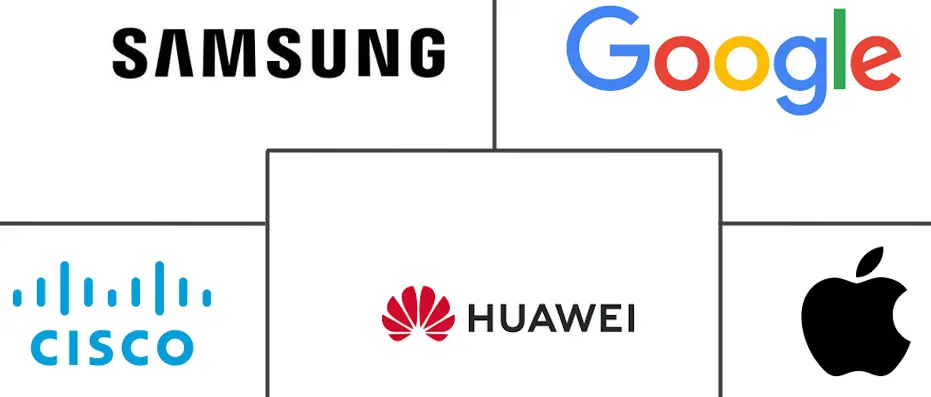IoT Devices Market Size and Share
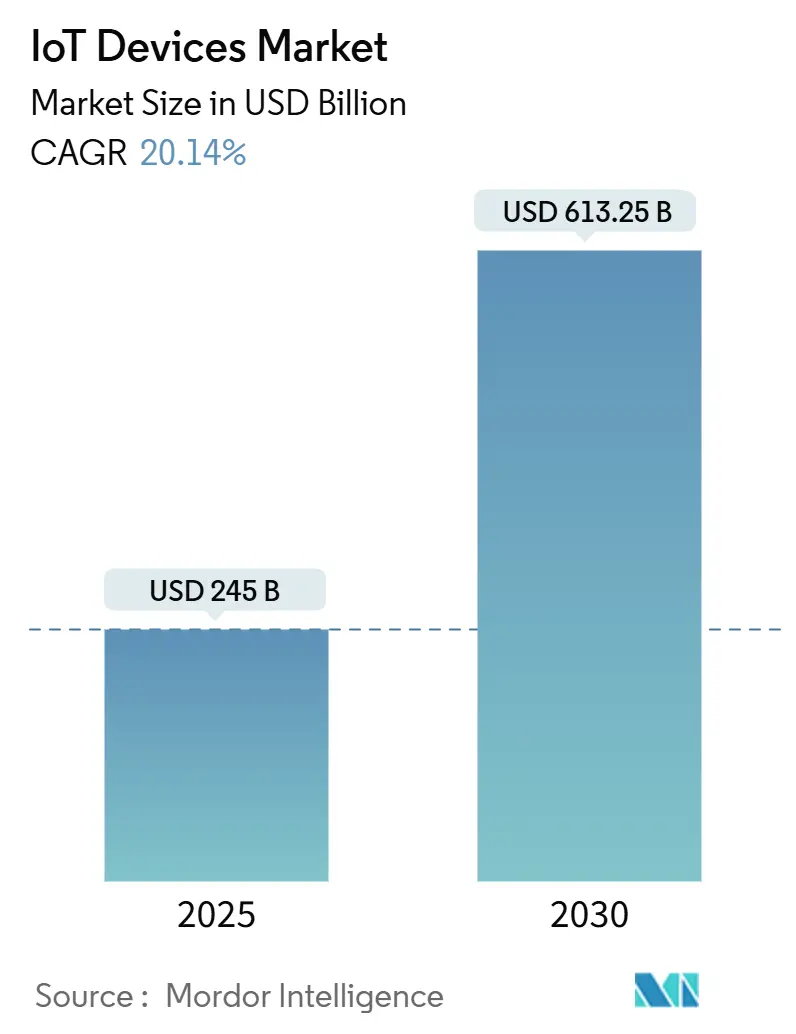
IoT Devices Market Analysis by Mordor Intelligence
The IoT Devices Market size is estimated at USD 245 billion in 2025, and is expected to reach USD 613.25 billion by 2030, at a CAGR of 20.14% during the forecast period (2025-2030).
Growth is powered by three mutually reinforcing trends: rapid global 5G and LPWAN roll-outs, falling edge-AI silicon costs, and expanding enterprise appetite for real-time insights that improve efficiency and cut downtime. Security and interoperability mandates are reshaping design priorities as the U.S. Cyber Trust Mark and Europe’s EN 18031 impose minimum requirements on encryption, firmware updates, and lifecycle support. Meanwhile, the Matter specification is simplifying onboarding across brands, encouraging households and factories to add incremental devices without lock-in friction. Semiconductor shortages linger, but vertically integrated players are cushioning ultra-low-power MCU gaps through multi-sourcing and in-house design, sustaining momentum for the IoT devices market despite continued supply volatility.
Key Report Takeaways
- By application, Connected & Smart Home held 32% revenue share in 2024; Medical IoT is set to expand at a 23.48% CAGR through 2030.
- By device category, Smart Speakers & Displays accounted for 24.5% of the IoT devices market share in 2024, while Wearables posted the fastest 22.73% CAGR outlook.
- By connectivity, cellular solutions represented 40.2% of the IoT devices market size in 2024; LPWAN technologies are forecast to grow at 22.20% CAGR between 2025-2030.
- By geography, Asia Pacific dominated with 38.4% revenue share in 2024 and leads regional growth with a 21.46% CAGR to 2030.
Global IoT Devices Market Trends and Insights
Drivers Impact Analysis
| Driver | (~) % Impact on CAGR Forecast | Geographic Relevance | Impact Timeline |
|---|---|---|---|
| 5G & LPWAN roll-outs accelerating massive IoT shipments | +5.20% | China, North America, Europe | Medium term (2-4 years) |
| Smart-meter mandates driving connected-energy devices | +3.80% | Europe, North America, China, India | Medium term (2-4 years) |
| Edge-AI silicon cost decline expanding vision-enabled industrial IoT | +4.10% | North America, Europe, East Asia | Short term (≤ 2 years) |
| Reimbursement policies boosting remote-patient monitoring devices | +4.60% | North America, Europe, Japan | Medium term (2-4 years) |
| Source: Mordor Intelligence | |||
5G and LPWAN Roll-outs Accelerating Massive-IoT Shipments
Global operators are lighting up standalone 5G and NB-IoT overlays that lower per-device data costs by more than 40%, enabling agriculture, logistics, and utility projects that were previously uneconomic. NB-IoT now captures 84% of China’s massive IoT links, while LoRaWAN holds 40% global share, two ecosystems that dictate radio design and module sourcing choices for OEMs. The release of 5G RedCap chipsets is expected to connect 5 billion low-power devices by 2025, bridging today’s cost gap between LTE-M and full 5G NR. Together, these factors expand the addressable pool for the IoT devices market and inject 5.2 percentage points into the CAGR forecast.
Smart-Meter Mandates Driving Connected-Energy Devices
Regulators across the EU, the United States, and India are mandating smart meter roll-outs that guarantee multi-year device demand. Households facing volatile electricity tariffs are adopting Matter-compliant thermostats and load controllers, with unit sales projected to climb 11% in 2025[1]Parks Associates, “Energy Device Adoption Study 2025,” parksassociates.com. Utilities see double-digit operational savings from automated outage alerts and real-time consumption data, a driver that contributes +3.8% to the IoT devices market CAGR.
Edge-AI Silicon Cost Decline Expanding Vision-Enabled Industrial IoT
AI accelerators optimized for sub-1 W operation have fallen below USD 5 per unit in volume, unlocking in-line visual inspection at mid-sized factories previously priced out of machine-vision adoption. The IoT chip segment is forecast to balloon from USD 12.77 billion in 2024 to USD 78.73 billion by 2032, lifting the value proposition of local inference over cloud processing. Edge-based defect detection reduces scrap rates by up to 30%, translating to rapid ROI and adding 4.1 percentage points to overall growth.
Reimbursement Policies Boosting Remote-Patient Monitoring Devices
Updated CPT codes now reimburse U.S. clinicians for 16-day continuous monitoring, and Europe’s digital-health frameworks fund connected glucometers and wearables, moving Medical IoT from pilot to mainstream deployments. Estimates point to USD 63 billion in global healthcare savings enabled by IoT, with payers directing funds toward solutions that reduce emergency visits. These economics inject +4.6 percentage points into the IoT devices market’s CAGR forecast.
Restraints Impact Analysis
| Restraint | (~) % Impact on CAGR Forecast | Geographic Relevance | Impact Timeline |
|---|---|---|---|
| Fragmented firmware update ecosystems creating cyber-risk | -2.80% | North America, Europe | Medium term (2-4 years) |
| Semiconductor supply volatility for ultra-low-power MCUs | -2.10% | Asia manufacturing hubs | Short term (≤ 2 years) |
| Source: Mordor Intelligence | |||
Fragmented Firmware Update Ecosystems Creating Cyber-Risk
Over 40 billion endpoints will be live by 2025, yet a third lack secure OTA update paths, leaving un-patched vulnerabilities that raise breach costs by 27% on average. The Cyber Trust Mark label aims to help consumers pick secure devices, but its voluntary nature limits global enforcement, shaving 2.8 percentage points off growth until harmonized standards emerge.
Semiconductor Supply Volatility for Ultra-Low-Power MCUs
A surge in AI accelerator demand collided with natural-disaster disruptions at Korean and Taiwanese fabs, restricting shipments of 28-nm and 40-nm MCUs used in sensor nodes. TSMC reported 17% YoY revenue growth in Q1 2024 after adding capacity, yet shortages linger and trim 2.1 points from near-term CAGR.
Segment Analysis
By Application: Healthcare Redefines Connected Value
Connected & Smart Home led the IoT devices market with 32% revenue in 2024 as voice-first hubs and seamless Matter onboarding spurred multi-device bundles. Medical IoT, forecast at a 23.48% CAGR, benefits from pay-for-performance reimbursement and increasingly accurate biosensors. Industrial IoT contributes a USD 275.70 billion opportunity by 2025 as edge vision lowers inspection costs. Connected automotive platforms gain momentum under V2X mandates, while municipal spending on smart-city systems is set to exceed USD 300 billion by 2026. Complementary growth in agriculture and personal wearables rounds out a diversified application mix that underpins resilient demand for the IoT devices market.
The influx of generative AI into smart speakers is expected to raise unit shipments 25% in 2025, delivering natural language scenarios that cut user friction. Remote-patient devices are integrating predictive analytics to flag anomalies five days before clinical escalation, a shift that reduces hospital readmissions by up to 18%. Manufacturing plants leveraging AI-guided predictive maintenance report 15% downtime reduction. Cities deploy computer-vision nodes to optimize parking occupancy and traffic signal timing, shaving commuter time by 10% and reducing carbon footprints for metropolitan areas.
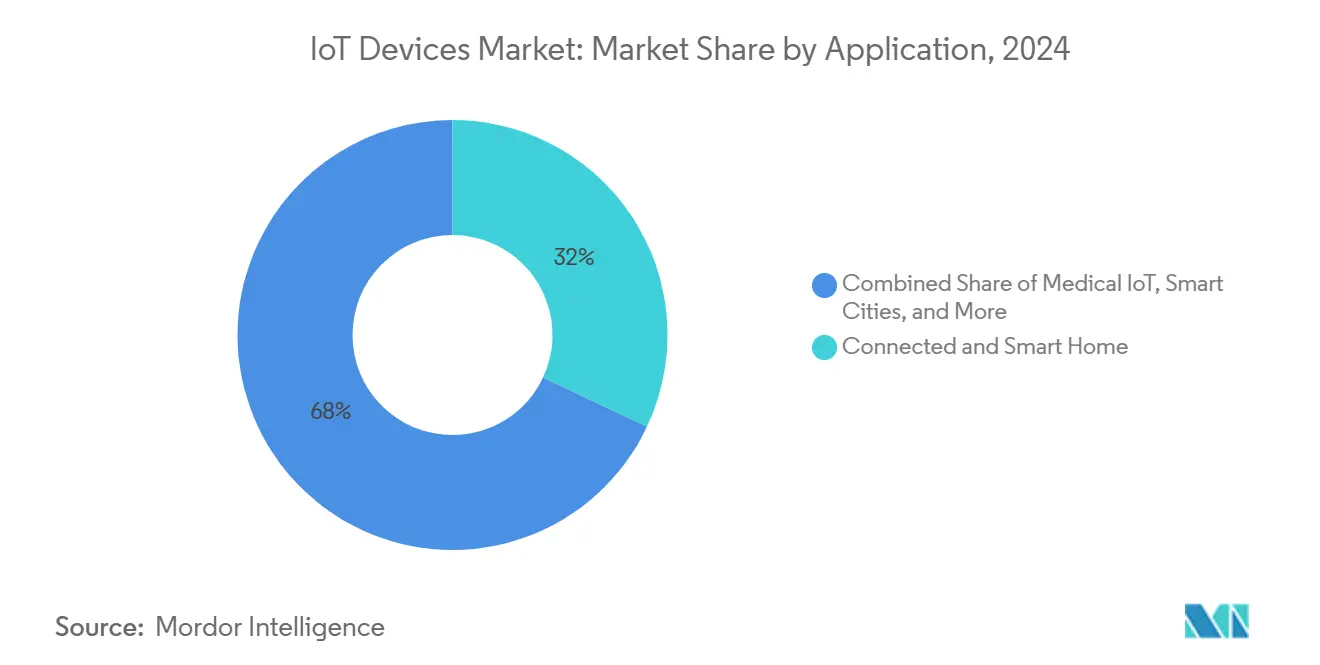
Note: Segment shares of all individual segments available upon report purchase
By Device Category: Wearables Outpace Traditional Devices
Smart Speakers & Displays retained a 24.5% share in 2024, acting as central orchestrators for lighting, media, and security tasks. The IoT devices market size for these hubs is projected to surpass USD 90 billion by 2030 as multi-modal sensing (vision, radar, air-quality) adds incremental value. Wearables post the swiftest 22.73% CAGR, driven by FDA-cleared algorithms that convert consumer watches into medical-grade heart monitors. Appliance OEMs, 97% of whom plan Matter integration, are rolling out connected ovens, dishwashers, and HVAC systems that auto-optimize energy use[2]Jabil Inc., “OEM Perspectives on Matter Adoption,” jabil.com.
Industrial sensors leverage falling-edge AI silicon costs to embed local analytics for vibration-based predictive maintenance. Connected cameras integrate on-device object recognition, cutting uplink bandwidth by 60%. Micro-mobility trackers, now standard on e-bike leases in Europe, reduce theft incidents by 35% and feed live fleet data back to operators. Collectively, these sub-categories broaden the IoT devices market and increase cross-sell potential throughout the device lifecycle.
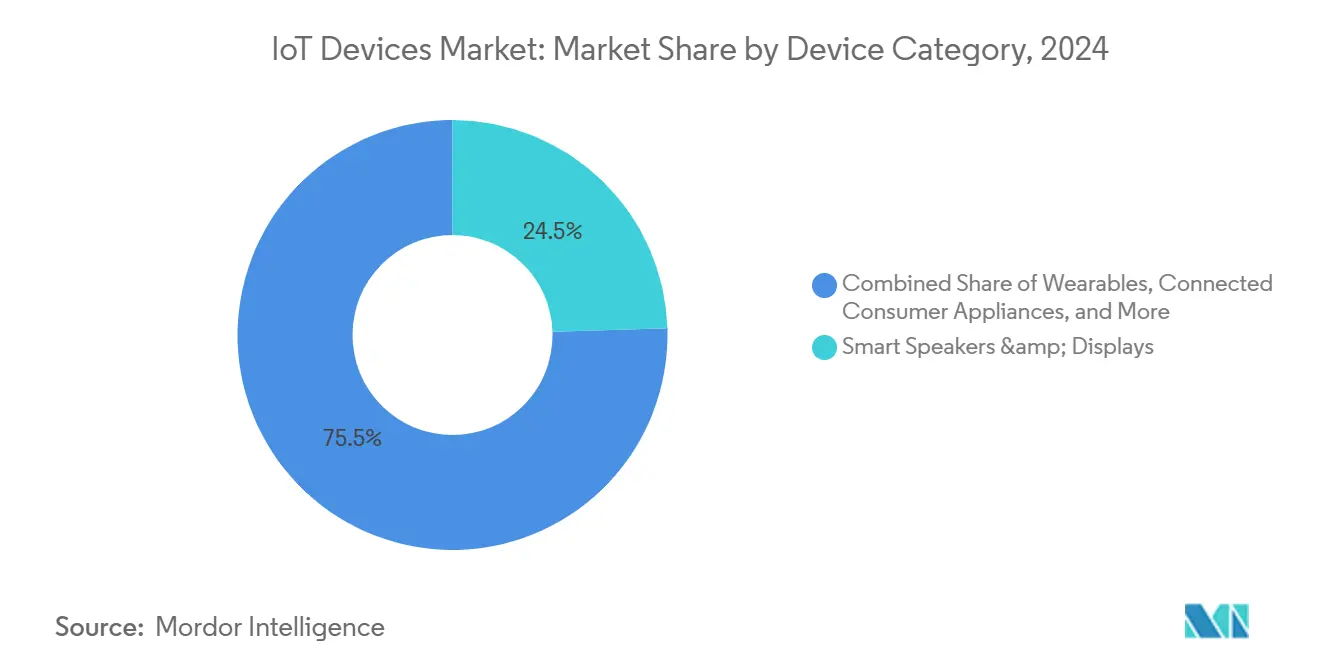
Note: Segment shares of all individual segments available upon report purchase
By Connectivity Technology: LPWAN Challenges Cellular Dominance
Cellular links delivered 40.2% of overall connections in 2024, supported by legacy 4G and emerging 5G RedCap modules that extend battery life beyond 10 years. LPWAN options such as NB-IoT, LoRaWAN, and Sigfox are expanding fastest at 22.20% CAGR, doubling to 3.5 billion links by 2030. WPAN standards, Bluetooth LE, Zigbee, and Z-Wave, remain staples for low-power mesh, whereas Wi-Fi 6E and Wi-Fi 7 deliver 5 Gbps-plus throughput for bandwidth-hungry cameras. Satellite IoT, enabled by 3GPP Release 17 NTN support, is on pace to hit 41 million connections by 2030 and is essential for energy, maritime, and remote-asset verticals.
Geography Analysis
Asia Pacific led the IoT devices market with 38.4% share in 2024 and is poised for a 21.46% CAGR to 2030, powered by Chinese manufacturing digitalization and national smart-city budgets across Japan, South Korea, and India. China’s NB-IoT footprint underpins more than 1 billion active modules, while Japan and South Korea integrate 5G in production lines to hit Six Sigma quality benchmarks. India’s market is forecast to reach USD 15 billion by 2025 as agricultural IoT and public-sector digital-service programs scale. Regional investments in AI and generative AI will grow 24% annually to hit USD 110 billion by 2028, reinforcing demand for intelligent edge nodes[3]Knight Frank, “Asia-Pacific Generative AI Investment Outlook,” knightfrank.com.
North America ranks second in revenue, anchored by advanced healthcare deployments and smart-home penetration. The average U.S. household hosts 17 connected devices, and 45% own at least one smart-home product. The Cyber Trust Mark label launches in August 2025, steering consumer preference toward certified secure devices. Canada expands industrial IoT in mining and energy, while Mexico’s maquiladoras integrate predictive maintenance to improve OEE by 12%.
Europe maintains a robust position thanks to stringent privacy and energy regulations that accelerate smart-meter roll-outs and medical-device security upgrades. EN 18031 takes effect in August 2025, compelling encryption, secure boot, and coordinated disclosure processes. Germany and the Nordics prioritize smart-grid deployments, while the UK’s medical-technology sector pursues a 6.1% CAGR through robotics and telehealth integration. The Middle East invests in AI-enabled water-management systems, and Brazil uses satellite-linked sensors to monitor 35 million hectares of farmland.
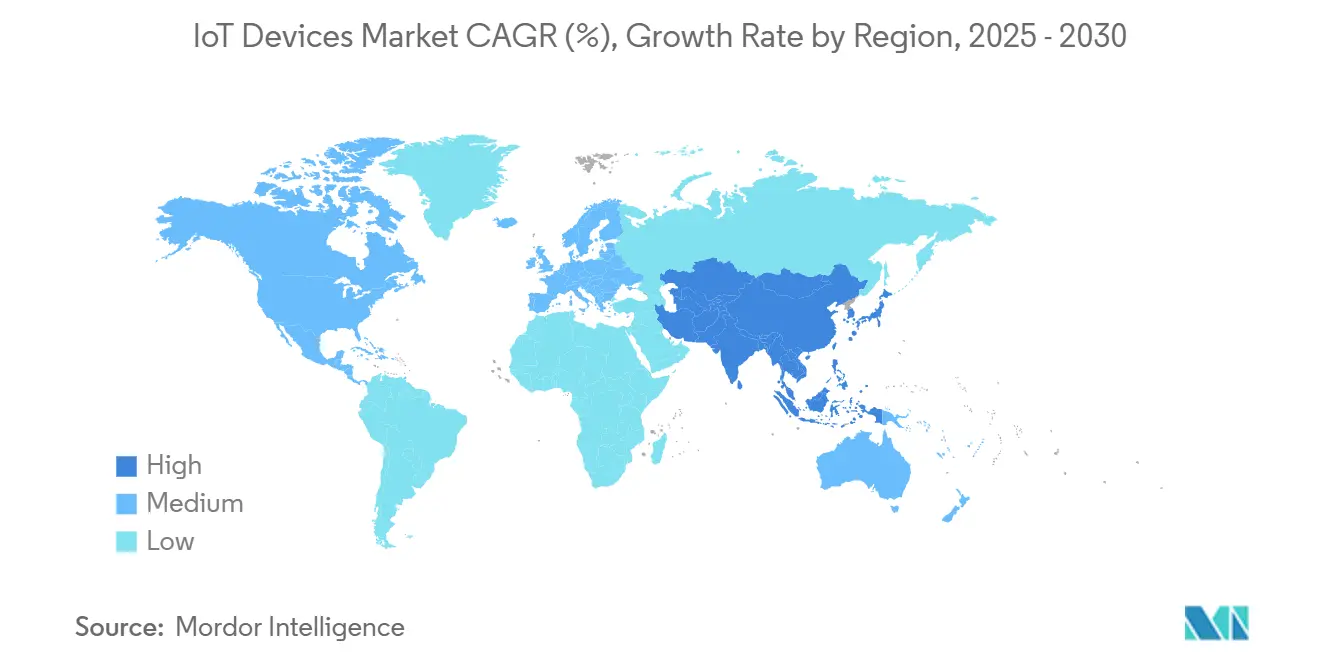
Competitive Landscape
Competition in the IoT devices market splits along consumer and industrial lines. Consumer segments see Apple, Amazon, Google, and Samsung leveraging closed software stacks, economies of scale, and brand loyalty. Industrial and vertical applications remain more fragmented, with Siemens, Schneider Electric, and Honeywell commanding plant-floor solutions, while start-ups specialize in asset-specific sensors. The Matter standard is forcing incumbents to open application layers, smoothing inter-brand collaboration, and eroding proprietary moats.
Strategic M&A is central to capability expansion. Qualcomm secured Edge Impulse to give 170,000 developers an end-to-end AI workflow optimized for its SoCs. NXP agreed to buy Kinara for USD 307 million, adding SRAM-efficient vision accelerators that slot into automotive ADAS and industrial cameras. Ambient energy pioneers cooperate through the Ambient IoT Alliance, led by Intel and PepsiCo, to remove batteries from logistic tags and reduce lifecycle emissions.
Supply-chain resilience dictates competitive advantage. Companies with in-house chip design plus multi-foundry allocations, such as Apple and Huawei, navigate MCU shortages better than rivals dependent on a single-source supply. Security certification under EN 18031 and the Cyber Trust Mark has become a requirement for big-box retail placement, pressuring late adopters to accelerate secure-boot and vulnerability-disclosure programs. This dynamic rewards early-compliant vendors with shorter time-to-shelf.
IoT Devices Industry Leaders
-
Apple Inc.
-
Cisco Systems Inc
-
Google Inc. (Alphabet)
-
Samsung Electronics Co. Limited
-
Huawei Technologies Co. Ltd.
- *Disclaimer: Major Players sorted in no particular order
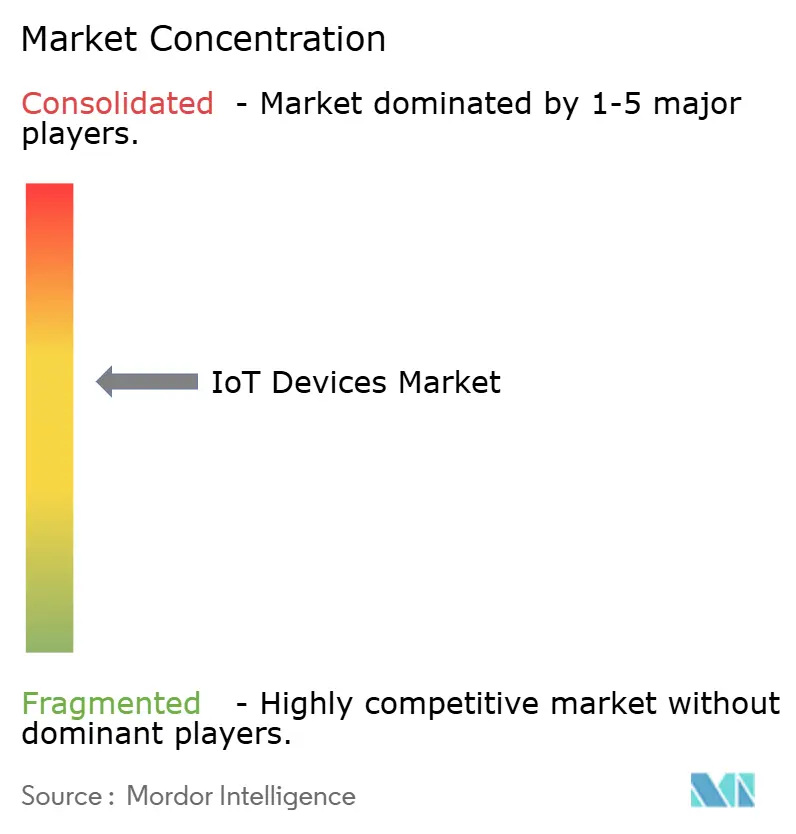
Recent Industry Developments
- May 2025: Qualcomm completed the Edge Impulse acquisition, enabling on-device AI model deployment across its processor range.
- March 2025: The Ambient IoT Alliance unveiled battery-free tags powered by ambient RF and photovoltaic sources to cut supply-chain emissions.
- January 2025: The Commerce Department launched the Cyber Trust Mark to label consumer IoT that meets baseline security requirements.
- December 2024: The FCC finalized rules permitting C-V2X in the 5.9 GHz band to accelerate connected-car deployments.
Global IoT Devices Market Report Scope
IoT is a network of internet-connected objects. These objects collect and exchange data using sensors embedded within them. IoT systems connect specialized devices designed for specific purposes with limited programmability and customizability. Moreover, IoT systems also store and process data in a distributed manner.
The IoT Devices Market is segmented by Application type (connected & smart home, medical IoT, connected car, smart cities, industrial IoT, personal IoT), by connectivity type (WPAN, WLAN, LPWA, cellular/M2M), by geography (North America, Europe, Asia Pacific, Latin America, Middle East and Africa).
The market sizes and forecasts are provided in terms of value in USD for all the above segments.
| Connected and Smart Home |
| Medical IoT |
| Connected Car |
| Smart Cities |
| Industrial IoT |
| Personal IoT |
| Smart Agriculture |
| Other Applications |
| Smart Speakers and Displays |
| Wearables (Watches, Bands, Hearables) |
| Connected Consumer Appliances |
| Smart Energy and Utility Devices (Meters, Thermostats) |
| Industrial Sensors and Actuators |
| Connected Cameras and Security Devices |
| Micro-mobility Trackers |
| WPAN (Bluetooth, Zigbee, Z-Wave) |
| WLAN (Wi-Fi 4/5/6/6E/7) |
| LPWAN (NB-IoT, LTE-M, LoRa, Sigfox) |
| Cellular (4G, 5G, C-V2X) |
| Satellite IoT |
| Other Connectivity |
| North America | United States |
| Canada | |
| Mexico | |
| South America | Brazil |
| Argentina | |
| Rest of South America | |
| Europe | Germany |
| United Kingdom | |
| France | |
| Italy | |
| Rest of Europe | |
| Asia-Pacific | China |
| Japan | |
| India | |
| South Korea | |
| ASEAN | |
| Rest of Asia-Pacific | |
| Middle East | Saudi Arabia |
| United Arab Emirates | |
| Rest of Middle East | |
| Africa | South Africa |
| Nigeria | |
| Rest of Africa |
| By Application | Connected and Smart Home | |
| Medical IoT | ||
| Connected Car | ||
| Smart Cities | ||
| Industrial IoT | ||
| Personal IoT | ||
| Smart Agriculture | ||
| Other Applications | ||
| By Device Category | Smart Speakers and Displays | |
| Wearables (Watches, Bands, Hearables) | ||
| Connected Consumer Appliances | ||
| Smart Energy and Utility Devices (Meters, Thermostats) | ||
| Industrial Sensors and Actuators | ||
| Connected Cameras and Security Devices | ||
| Micro-mobility Trackers | ||
| By Connectivity Technology | WPAN (Bluetooth, Zigbee, Z-Wave) | |
| WLAN (Wi-Fi 4/5/6/6E/7) | ||
| LPWAN (NB-IoT, LTE-M, LoRa, Sigfox) | ||
| Cellular (4G, 5G, C-V2X) | ||
| Satellite IoT | ||
| Other Connectivity | ||
| By Geography | North America | United States |
| Canada | ||
| Mexico | ||
| South America | Brazil | |
| Argentina | ||
| Rest of South America | ||
| Europe | Germany | |
| United Kingdom | ||
| France | ||
| Italy | ||
| Rest of Europe | ||
| Asia-Pacific | China | |
| Japan | ||
| India | ||
| South Korea | ||
| ASEAN | ||
| Rest of Asia-Pacific | ||
| Middle East | Saudi Arabia | |
| United Arab Emirates | ||
| Rest of Middle East | ||
| Africa | South Africa | |
| Nigeria | ||
| Rest of Africa | ||
Key Questions Answered in the Report
What is the projected value of the IoT devices market by 2030?
The IoT devices market is forecast to reach USD 613.25 billion in 2030 on a 20.14% CAGR trajectory.
Which region contributes the most revenue today?
Asia Pacific leads with a 38.4% revenue share, underpinned by large-scale NB-IoT deployments and government-funded smart-city projects.
Which application segment is growing fastest?
Medical IoT devices hold the highest growth outlook at a 23.48% CAGR as payers reimburse remote-patient monitoring.
How does the Matter protocol influence the market?
Matter simplifies interoperability across brands, reducing setup friction and accelerating multi-device adoption in both homes and factories.
Why is edge AI considered critical for industrial IoT?
Falling accelerator costs let manufacturers run real-time visual inspection locally, cutting latency and improving product quality without cloud fees.
What new security rules apply to IoT devices in 2025?
The Cyber Trust Mark in the United States and EN 18031 in Europe establish baseline encryption, secure-update, and vulnerability-disclosure requirements that vendors must meet to access major channels.
Page last updated on:
